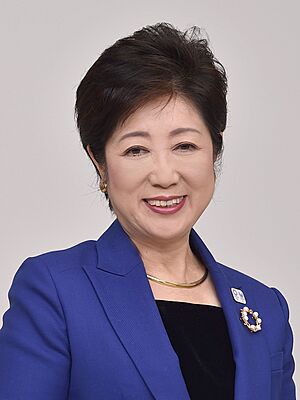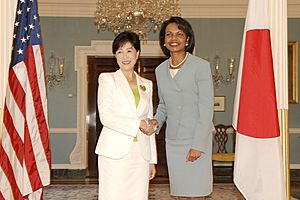Yuriko Koike facts for kids
Quick facts for kids
Yuriko Koike
|
|
|---|---|
|
小池 百合子
|
|

Official portrait, c. 2017
|
|
| Governor of Tokyo | |
| Assumed office 1 August 2016 |
|
| Monarch | Akihito Naruhito |
| Deputy | Mitsuchika Tarao Hiroshi Kajihara Kei Takechi Manabu Miyasaka |
| Preceded by | Yōichi Masuzoe |
| Minister of Defense | |
| In office 4 July 2007 – 27 August 2007 |
|
| Prime Minister | Shinzo Abe |
| Preceded by | Fumio Kyūma |
| Succeeded by | Masahiko Kōmura |
| Minister of State for Okinawa and Northern Territories Affairs | |
| In office 27 September 2004 – 26 September 2006 |
|
| Prime Minister | Junichiro Koizumi |
| Preceded by | Toshimitsu Motegi |
| Succeeded by | Sanae Takaichi |
| Minister of the Environment | |
| In office 22 September 2003 – 26 September 2006 |
|
| Prime Minister | Junichiro Koizumi |
| Preceded by | Shunichi Suzuki |
| Succeeded by | Masatoshi Wakabayashi |
| Member of the House of Representatives | |
| In office 19 July 1993 – 14 July 2016 |
|
| Preceded by | Yoshitada Konoike |
| Succeeded by | Masaru Wakasa |
| Constituency | Hyōgo 2nd (1993–1996) Hyōgo 6th (1996–2003) Kinki PR (2003–2005) Tokyo 10th (2005–2009; 2012–2016) Tokyo PR (2009–2012) |
| Member of the House of Councillors | |
| In office 26 July 1992 – 4 July 1993 |
|
| Preceded by | Multi-member district |
| Succeeded by | Yoriko Madoka |
| Constituency | National PR |
| Personal details | |
| Born | 15 July 1952 Ashiya, Hyōgo, Japan |
| Political party | Independent (since 2018) |
| Other political affiliations |
JNP (1992–1994) NFP (1994–1997) LP (1997–2000) NCP (2000–2003) LDP (2003–2017) TFnK (2017) KnT (2017–2018) |
| Alma mater | Kwansei Gakuin University American University in Cairo Cairo University |
| Signature | |
Yuriko Koike (小池 百合子, Koike Yuriko; born 15 July 1952) is a Japanese politician. She has been the Governor of Tokyo since 2016. Tokyo is the capital city of Japan.
Before becoming governor, she was a member of Japan's parliament. She served in the House of Councillors from 1992 to 1993. Then, she was in the House of Representatives from 1993 to 2016.
Koike also held important roles in the government. She was the Minister of the Environment from 2003 to 2006. She also briefly served as Minister of Defense in 2007.
She was born and grew up in Ashiya, Hyōgo, a city near Kobe. She studied in Cairo, Egypt, and graduated from Cairo University in 1976.
In 2016, Koike was elected Governor of Tokyo. She was the first woman to hold this position. She was re-elected in 2020 and again in 2024.
Contents
Early Life and Education
Yuriko Koike was born on 15 July 1952 in Ashiya, Hyōgo. She attended Kōnan Girls' Junior and Senior High School. Her father, Yūjirō Koike, was a merchant who dealt with oil. He was also involved in politics.
Her father believed it was important for Japan to have strong ties with Arab countries. This was to make sure Japan had a steady supply of oil.
Koike studied Arabic at the American University in Cairo. She then graduated from Cairo University in October 1976. When she was 21, she married a fellow student but divorced soon after.
She started her career as an interpreter for Arabic. Later, she became a journalist. She interviewed famous leaders like Muammar Gaddafi and Yasser Arafat in 1978. In 1979, she became a news anchor. She received an award for Female Broadcaster of Japan in 1990.
Studying at Cairo University
There have been questions about Koike's graduation from Cairo University. However, in June 2020, Cairo University stated that she did graduate from their Sociology department in October 1976.
These questions about her education first came up in 1992. They were reported more widely during the 2016 Tokyo governor election. Koike sent her graduation certificate to a Japanese news program to address the claims.
Political Career

After her studies, Koike began her political journey. She was elected to the House of Councillors in 1992. She was a member of the Japan New Party.
In 1993, she was elected to the House of Representatives. She represented the Hyogo 2nd district. She continued to be re-elected to the House of Representatives in different districts. In 2002, she joined the Liberal Democratic Party (LDP).
Serving in the Cabinet (2003–2007)
Koike held important roles in the government cabinet. She was the Minister of the Environment. She also served as Minister of State for Okinawa and Northern Territories Affairs. These roles were under Prime Minister Jun'ichirō Koizumi.
In June 2007, she became the first female Minister of Defense. This was during the first term of Prime Minister Shinzo Abe. She resigned from this post in August 2007.
Running for LDP Leader in 2008
On 8 September 2008, Koike decided to run for the leader of the LDP. This was a big step because she was the first woman to try to become the leader of a major Japanese political party. She said that Japan needed a female candidate to solve its problems.
She compared the challenge to a "glass ceiling" but said in Japan, it was an "iron plate." She aimed to break through it. In the election held on 22 September, she came in third place. Tarō Asō won the election.
Governor of Tokyo
After the previous Tokyo Governor resigned in 2013, Koike was considered a possible candidate. However, she did not run in the 2014 election.
When the next governor resigned in June 2016, Koike announced she would run. She was elected Governor of Tokyo on 31 July 2016. This made her the first woman to hold this important position.
On 21 August 2016, Koike received the Olympic Flag. This happened at the closing ceremony of the 2016 Summer Olympics in Rio de Janeiro. She received it from the mayor of Rio, as Tokyo was the next host city.
In May 2017, Koike left the Liberal Democratic Party. She became the official leader of a new group called Tomin First no Kai (Tokyoites First). This group aimed to win local elections in Tokyo. They formed an alliance with another party, Komeito.
In the prefectural election on 3 July 2017, Koike's alliance won a majority of seats. This meant they had control of Tokyo's parliament.
As governor, Koike led Tokyo's response to the COVID-19 pandemic in Japan. She also oversaw the postponement of the 2020 Tokyo Summer Olympics to 2021. The Olympics and Paralympics were successfully held in 2021. Most events were held without spectators due to the pandemic.
In August 2022, Koike met with the Governor of Jakarta, Indonesia. They discussed ways Tokyo and Jakarta could work together. This included ideas for environmentally friendly public transportation.
On 29 August 2022, Koike announced that Tokyo would start building the world's fastest mobile internet network. This project aims to improve digital services in the city.
Koike ran her campaigns on a platform of "seven zeros." These were goals to solve social and economic problems in Tokyo. She successfully reduced the number of children waiting for daycare spots. She also cut down on the number of dogs and cats euthanized. However, some other goals, like reducing crowded trains, are still being worked on.
In August 2024, Koike fractured her left knee during a baseball game. This meant she had to work remotely for a while.
Political Ideas
Yuriko Koike supports ideas that help the economy grow. She wants to make government services more efficient. She also believes in improving the status of women in the workplace. She has said that policies for women will benefit Tokyo.
Her main ideas for political reform are called "The 5 Cs": Check, Challenge, Change, Creative, and Communication. She supports selling off some government assets to reduce debt. She also wants to focus on IT development, science, and sustainable infrastructure.
Environmental Views
Koike cares about environmental issues. She learned about living simply from her experiences in Egypt. In 2005, she suggested a "carbon tax" to help Japan meet its environmental goals.
In 2006, she started the "Mottainai Furoshiki" campaign. This encouraged people to use traditional Japanese wrapping cloths instead of plastic bags. She also does not support using biofuels made from food crops.
Nationalism and Related Discussions
Koike is a nationalist. She was part of a group called the Diet Members' Committee of Nippon Kaigi. This is a large conservative group in Japan.
As Governor of Tokyo, she has faced criticism for not acknowledging the 1923 Kantō Massacre. This event mainly targeted ethnic Koreans. Since 2017, Koike has not offered condolences at the annual ceremony for the victims. She has stated that whether a massacre occurred is a matter of historical debate.
In 2016, questions were raised about her speaking at a conference hosted by a women's group. This group was said to have ties to an anti-Korean group. Koike stated she was not aware of any such ties.
Views on the Constitution
Koike's views on foreign policy and security are often seen as strong. She has suggested changing how Article 9 of Japan's Constitution is understood. This would allow the government to use its right to collective self-defense.
She has supported the United States and the "War on Terror." She has also pushed for stronger ties between Japan and other countries.
Other Political Views
Koike has also promoted Japanese pop culture. In 2015, she appeared in cosplay as Sally from Sally the Witch. During her 2016 campaign, she said she wanted to turn Tokyo into an "anime land."
In 2017, Koike started "Jisa Biz" (時差biz). This program encourages remote work and flexible work times. The goal is to reduce traffic congestion during rush hour in Tokyo.
In 2017, Koike launched a new national political party called Kibō no Tō (Party of Hope). She was the leader of this party while still Governor of Tokyo. The party did not perform as well as expected in the 2017 general election.
In 2023, she was ranked 62nd on Forbes' list of "World's 100 most powerful women."
See also
 In Spanish: Yuriko Koike para niños
In Spanish: Yuriko Koike para niños

